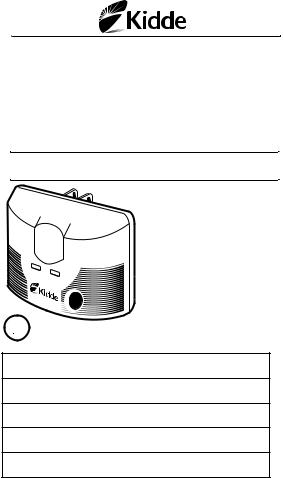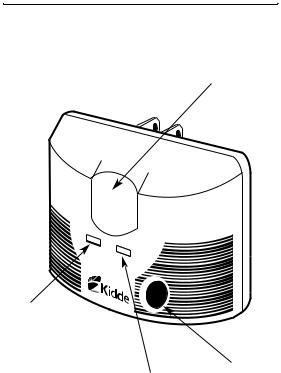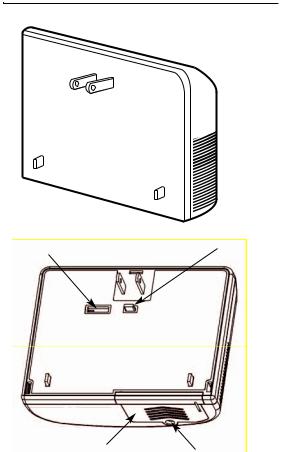Kidde KN-COB-LCB-A, KN-COB-DP-H User Manual

AC Powered
Carbon Monoxide
Alarm
User’s Guide
SIGNALING
UL
LISTED
Kidde Direct Plug CO Alarm Models:
KN-COB-DP-H Basic AC CO Alarm
KN-COB-LCB-A
Basic Alarm with Battery Backup and Tamper-Resist Features.
For questions concerning your Carbon Monoxide Alarm, please call our Consumer Hotline at 1-800-880-6788
Please have the following information ready when calling:
CO Alarm Model Number (Located on the back of alarm):
CO Alarm Assembly Number (Located on back of alarm):
Date of Manufacture (Located on back of alarm):
Date of Purchase:
Where Purchased:
ATTENTION: Please take a few minutes to thoroughly read this manual, which should be saved for future reference and passed on to any subsequent owner. If you have any questions about the operation or installation of your alarm, please call our toll free Consumer Hotline at 1-800-880-6788. 810-1852 REV. D
0905

Contents
Introduction
Quick Set Up Guide
Part One – Your Kidde CO Alarm
•About your CO alarm
•What CO alarms can and cannot do
•Where to install your alarm
•Where not to install your alarm
•How to install your alarm
•Normal operating characteristics
•Testing the electronics
•How to know if your alarm is malfunctioning
•How to care for your alarm
Part Two – Carbon Monoxide
•The effects of CO exposure
•Could your family be at risk for CO poisoning?
•Where CO comes from
•Protecting your family from CO posioning
•Home safety tips
Part Three – What You Should Know Before the Alarm Sounds
• Understand the effects of carbon monoxide exposure
Part Four – What to Do When the Unit Alarms
• How to respond to the alarm
Part Five – Technical Information
•Product Specifications
•How the unit determines when to alarm
Limited Warranty
• Limited Warranty

Introduction
Keep the guide in a handy location and refer to it when you have questions about your CO alarm, its functions, features, or if you have questions about carbon monoxide. Please read this guide in the sequence presented. You will then know how to use your CO alarm wisely and to know how to react in the event of an alarm
IMPORTANT
THIS CARBON MONOXIDE ALARM IS DESIGNED TO DETECT CARBON MONOXIDE FROM ANY SOURCE OF IMPROPER OR MALFUNCTIONING APPLIANCES. IT IS NOT DESIGNED TO DETECT SMOKE, FIRE, OR ANY OTHER GAS.
 WARNING!
WARNING!
CO ALARMS ARE NOT SMOKE ALARMS. CO ALARMS DO NOT SENSE SMOKE OR FIRE. FOR EARLY WARNING OF FIRE YOU MUST INSTALL SMOKE ALARMS, EVEN THOUGH CARBON MONOXIDE CAN BE GENERATED BY FIRE. THIS CARBON MONOXIDE ALARM IS NOT A SUBSTITUTE FOR INSTALLING AND MAINTAING AN APPROPRIATE NUMBER OF SMOKE ALARMS IN YOUR HOME. FOR THIS REASON YOU MUST INSTALL SMOKE ALARMS TO PROVIDE EARLY WARNING OF FIRE AND TO PROTECT YOU AND YOUR FAMILY FROM FIRE AND ITS RELATED HAZARDS.
THIS PRODUCT IS INTENDED FOR USE IN ORDINARY INDOOR RESIDENTIAL AREAS. IT IS NOT DESIGNED TO MEASURE COMPLIANCE WITH COMMERCIAL AND INDUSTRIAL STANDARDS. IT IS NOT SUITABLE FOR INSTALLATION IN HAZARDOUS LOCATIONS AS DEFINED IN THE NATIONAL ELECTRIC CODE.
MODELS WITHOUT BATTERY BACKUP WILL NOT OPERATE DURING POWER FAILURE. MODEL KN-COB-DP-H WILL NOT WORK WITHOUT POWER. THIS CO ALARM REQUIRES A CONTINUOUS SUPPLY OF ELECTRICAL POWER.
MODEL KN-COB-LCB-A REQUIRES A CONTINUOUS SUPPLY OF ELECTRICAL POWER. DURING A POWER OUTAGE IT WILL WORK FOR AT LEAST 20 HOURS IF A BATTERY WITH FULL CAPACITY IS INSTALLED PROPERLY.
THE INSTALLATION OF THIS DEVICE SHOULD NOT BE USED AS A SUBSTITUTE FOR PROPER INSTALLATION, USE AND MAINTENANCE OF FUELBURNING APPLIANCES, INCLUDING APPROPRIATE VENTILATION AND EXHAUST SYSTEMS.
INDIVIDUALS WITH MEDICAL PROBLEMS MAY CONSIDER USING WARNING DEVICES THAT PROVIDE AUDIBLE AND VISUAL SIGNALS FOR CARBON MONOXIDE CONCENTRATIONS UNDER 30 PPM.
CAUTION: THIS ALARM WILL ONLY INDICATE THE PRESENCE OF CO GAS AT THE SENSOR. CO MAY BE PRESENT IN OTHER AREAS.
1

Introduction
This Kidde carbon monoxide (CO) alarm is an important part of your family’s home safety plan. As a new owner of a CO alarm, there are some basic facts you should know for your protection and convenience.
Many people think that CO alarms operate like smoke alarms. Like smoke alarms, CO alarms monitor the air in your home and sound a loud alarm to warn you of trouble.
The way you respond to a CO alarm is quite different than a smoke alarm. That’s because a house fire and a carbon monoxide problem are two distinctly different situations. If your smoke alarm were to alarm, you would quickly be able to judge the level of danger you were in with your senses. You can see and smell the smoke, feel the heat, see, and possibly hear the fire burning. You can also readily see if your smoke alarm is alarming in a non-emer- gency situation, for example toast burning in the kitchen. Because your sense of sight, smell, hearing and touch give you information, you can almost instantly judge what action to take if you hear your smoke alarm.
Carbon monoxide (CO) is an invisible, odorless, tasteless and nonirritating gas–completely undetectable to your senses. That’s why it is so important to your safety that you have a carbon monoxide alarm.
Please take the time to completely read this guide to familiarize yourself with the facts about carbon monoxide, how your new unit works, and what to do if it alarms. Find a handy place to keep this manual so that it will be readily available when you have a question.
Thank you for making Kidde a part of your complete home safety program. With proper installation and use, your new Kidde CO alarm will provide you with years of dependable service.
2

Quick Set Up Guide
We urge you to read this entire manual in the sequence it is presented.
Listed below are five easy steps for setting up your Kidde CO alarm. Please read the entire guide for complete information.
Setting up your CO alarm for first time operation:
Step 1
Determine the best location for your CO alarm(s). Usually this is in or near bedrooms. Refer to Part One, Where to Install Your CO Alarm for complete information.
Step 2
For model KN-COB-LCB-A remove the yellow pull-tab or install the battery shipped with your unit
Plug the CO alarm into a standard, unswitched 120 volt AC electric outlet.
Step 3
The green Operate light will come on and stay on showing the CO alarm is receiving power.
Step 4
Next, test the alarm’s operation by pressing and releasing the Test/Reset button. The unit will beep quickly 4 times – followed by 5 seconds of silence – followed by 4 quick beeps. This is also the alarm cycle in the event of a CO problem. Familiarize yourself and household members with this alarm pattern. The red alarm light will come on when the alarm sounds.
Step 5
While testing the CO alarm, have someone else check that the alarm can be heard easily from the sleeping areas. The CO alarm should be located where it can wake you if it alarms at night.
Your Kidde CO alarm is now monitoring for the presence of carbon monoxide.
3

Part One – Your Kidde CO Alarm
About Your CO Alarm
While many other CO alarms require costly sensors or a proprietary battery pack replacement, there are no replacement parts on Kidde CO alarms and they use standard alkaline batteries (if equipped).
|
Test/Reset |
Kidde CO Alarm – front view |
Button |
|
|
Green
Operate
Light
Sounder
Red Alarm
Alarm
Light
4

Part One – Your Kidde CO Alarm
Kidde CO Alarm – rear view
Direct
(KN
Tamper-Resist Activation Switch
Tamper-Resist See Normal Operating Characteristics
Disable Switch
9Volt Battery Door |
Screw |
|
(Used With Tamper-Resist Feature) |
Direct plug unit with battery backup
(KN-COB-LCB-A )
5

Part One – Your Kidde CO Alarm
This Kidde Alarm’s Unique Features
Test/Reset Button
This button has two functions:
1)Press this is the button to test the unit weekly.
2)Press this button if the unit alarms to silence the alarm. This will reset the unit and it will then start monitoring for CO. If the CO concentration is above 70 ppm the alarm will again sound within 6 minutes.
Sensor
The sensor is a highly sensitive, electrochemical sensor that is CO-specific to help avoid false alarms.
Sounder Alarm
This is the loud 85 decibel pulsing alarm that will sound to alert you to a potential problem.
9V Backup Battery (Model KN-COB-LCB-A only)
This CO alarm is not battery operated; the 9V battery is to supply a short-term backup during a power outage. In the event of a power outage, the 9V battery will continue operating the alarm for at least 20 hours.
Low Battery HUSH® (Model KN-COB-LCB-A only)
By pressing the button on the CO alarm while it is in low battery mode you can stop the alarm from producing a low battery warning for up to twelve hours in order to maintain protection without having to replace the battery at an inconvenient time.
Tamper-Resist Feature (Model KN-COB-LCB-A only)
This is an alert to notify consumers the unit has been unplugged or has come loose from the outlet. This feature is not activated for two minutes after power is first supplied to give you time to plug the unit in after activating the battery. This feature is also disabled once the battery voltage has reached a level to cause a low battery warning chirp. This can be defeated for two minutes by pressing the Test button while the unit is removed from the plug to allow the battery to be changed without the 85dB alarm sounding. The feature can also be disabled by pressing in the Tamper-Resist Activation switch and moving the disable slide towards the switch. Use the included screw to secure the battery cover and increase tamper resistance.
6
